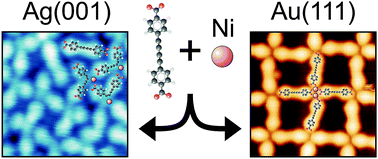Convergent and divergent two-dimensional coordination networks formed through substrate-activated or quenched alkynyl ligation†
Abstract
Metal coordination assemblies of the symmetric bi-functional 4,4′-di-(1,4-buta-1,3-diynyl)-benzoic acid are investigated by scanning tunnelling microscopy on metal surfaces. The formation of long-range ordered, short-range disordered and random phases depends on the competition between the convergent and divergent coordination motifs of the individual functional groups and is crucially influenced by the substrate.

- This article is part of the themed collection: Scanning Probe Studies of Molecular Systems

 Please wait while we load your content...
Please wait while we load your content...